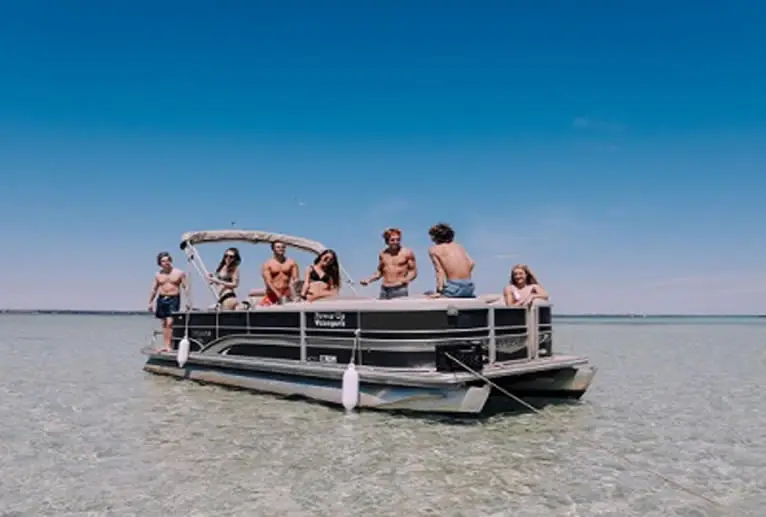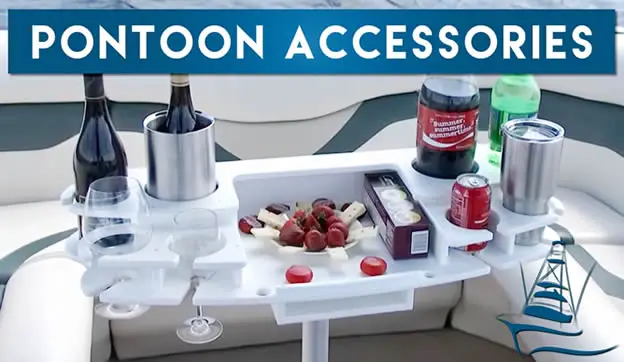Pontoon boats are great for a variety of different purposes but they are best known as a shallow draft boat that can be used in most inland bodies of water. But as many inland waterways have very shallow areas it is good to know just how shallow a pontoon boat can run. For this reason you need to know the average draft of a pontoon boat.
For an average 18′ – 20′ pontoon boat, with a balanced load, the draft will usually be between 16″ and 24″ draft down but with the motor trimmed up they can run as shallow as 10″. For larger pontoon boats 20′ – 24′, with a balanced load, the draft will be about 21″ draft down and 12″ draft up. Tritoons have a middle tube that sits lower in the water than the other two and so will run a bit deeper.
Contents
Average draft for pontoon boats based on size
The pontoon boat is so much more than just a party boat. With numerous different things you can do with and on a pontoon boat it is no wonder they are becoming more popular with each passing year.
One of the biggest benefits of using a pontoon boat is its ability to traverse shallow water.
As a shallow draft boat a pontoon boat is capable of accessing shallow waterways that other luxury boats just can’t get to, making it the number one choice for inland waterway luxury boating.
But how shallow can a pontoon boat float and run?
To answer this we need to know the average draft of a typical pontoon boat when it is draft down, (when the motor is trimmed down and the prop is fully in the water), and when it is it is draft up (when the motor is fully trimmed up and the prop is out of the water) .
Below are the average drafts of pontoon boats based on the boat carrying a balanced load:
- 18 feet – 20 feet: 16″ – 24″ with the prop down and an 10″ with the outboard trimmed up and prop out of the water.
- 20 feet – 24 feet: 20″- 24″ with the prop down and an 12″ with the outboard trimmed up and prop out of the water.
- Tritoons have an additional pontoon tube between the usual two tubes. This pontoon sits lower in the water giving the boat a deeper draft. See the manufacturer’s guidelines for the draft of a specific tritoon.
It is ok knowing the draft of your particular boat but when you don’t know what boat draft is then that information is useless to you. So, what is a boats’ draft?
What draft means on a boat
The draft of a boat refers to how deep it sits in the water. Boats are usually shallow draft, or deep draft or shoal draft. But, what does draft on a boat mean?
The draft of a boat refers to how deep the boat sits in the water. Deep draft boats that are used in the ocean sit low in the water with their lowest part deep below the waterline. A shallow draft boat will have its lowest part sitting not far below the waterline. Shoal draft boats are somewhere in-between the two.
As a pontoon boat has a shallow draft, this allows a pontoon boat to be used in shallow water of just a few feet.
Pontoon boat are among some of the best shallow boats on the market.
How load affects a pontoon boat’s draft
Be aware that the draft numbers for pontoon boats given above refer to a pontoon boat that has a balanced load.
If your pontoon boat has a very light load it will sit higher in the water and have a shallower draft. Alternatively, if the boat is heavily loaded and at its weight capacity this will greatly affect the draft of the boat because the pontoon tubes under the boat will be sitting lower in the water giving the boat a deeper draft.
A pontoon boat should also sit lower in the water at the rear of the boat than at the front, for this reason. So be aware that the draft of your pontoon boat refers to how deep the rear of the boat sits in the water.
How to use the draft measurement to protect your boat
Pontoon boats can often come with depth alarms to let you know when you are entering shallow water areas. If your boat is fitted with one of these don’t be overly reliant on it to tell you when you have entered the shallowest waters that your boat, and outboard motor, can handle.
If you are cruising at 15 -20 mph you will have almost no time to react should your alarm sound. At these speeds you can find your boat moving from 4 feet of water to bottom in just a few seconds.
For this reason it is a good idea to set your depth alarm to double the minimum of your particular pontoon boat.
I set my depth alarm to 7 feet when in unknown waters – just to be on the safe side. However, with a bit of local knowledge about the water body you are boating in, you will be much more equipped to deal with shallow water areas. Nothing can really take the place of preparation.
If you don’t have a depth alarm on your pontoon boat, get one!
Importance of trimming the outboard motor in shallow water to reduce the boat’s draft
Knowing how and when to trim the motor is an essential skill of driving a pontoon boat.
As you can see from the numbers given above there is a big difference in the draft of a pontoon boat draft down (when the motor is trimmed down and the prop is fully in the water) and when it is draft up (when the motor is fully trimmed up and the prop is out of the water).
It is a good idea to learn how to trim your outboard motor properly for navigating shallow waters so you don’t run the risk of damaging the prop.
Be aware that although a pontoon boat can be used to navigate very shallow water with the motor trimmed upped (some people will even carry a pole on the boat for punting it in very shallow water) you need to be aware of possible hidden dangers just below the water surface.
A pontoon boat with very little load may be able to float through water as shallow as 5″ or 6″ but if you take your boat in this environment you are running the very real risk of hitting submerged obstacles like rocks, debris or man-made junk. And, even if you don;t hit anything you run the risk of not getting out again because you can’t lower the prop.
Personally I will not take my boat into an area with shallow water that has a depth less than 24″ (2 feet) and I use my depth alarm to let me know when I reach (4 feet) so I can take appropriate action to get into deeper water.
The prop on my pontoon boat is typical in that it sits approximately 4″ lower than the pontoons, so realistically the boat will run easily with at least 12″ (1 foot) of water under the tubes, as long as there are no obstructions in the water or submerged hazards. However, I prefer to play safe unless I know the waters I am boating in or have done my research on the area.
It is advisable to install a prop guard to protect your prop in very shallow water as well when you trim the motor up slightly.
When you trim the motor up you will give the prop more bottom clearance to allow you to continue boating in more shallow areas. But, obviously this affects the performance of the motor however, as long as you leave enough of the prop in the water to ensure water is running through the engine you’ll be good to go.
You may be interested in reading our article on the 55 best pontoon boat accessories that will help you get the most out of your shallow water boat especially if you want to have a pontoon boat party.



